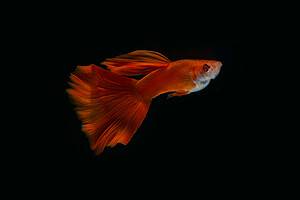Guppies are among the most popular aquarium fish for a reason. Their flamboyant colours and tail fins make a majestic addition to any indoor tank. In an outdoor environment, they even serve as a natural method of mosquito control. Watch out if you have more than one sex in the same environment, however: guppies breed voraciously! So exactly how long are guppies pregnant before moving on to a new batch of fry? Read on to find the answer to this and more!
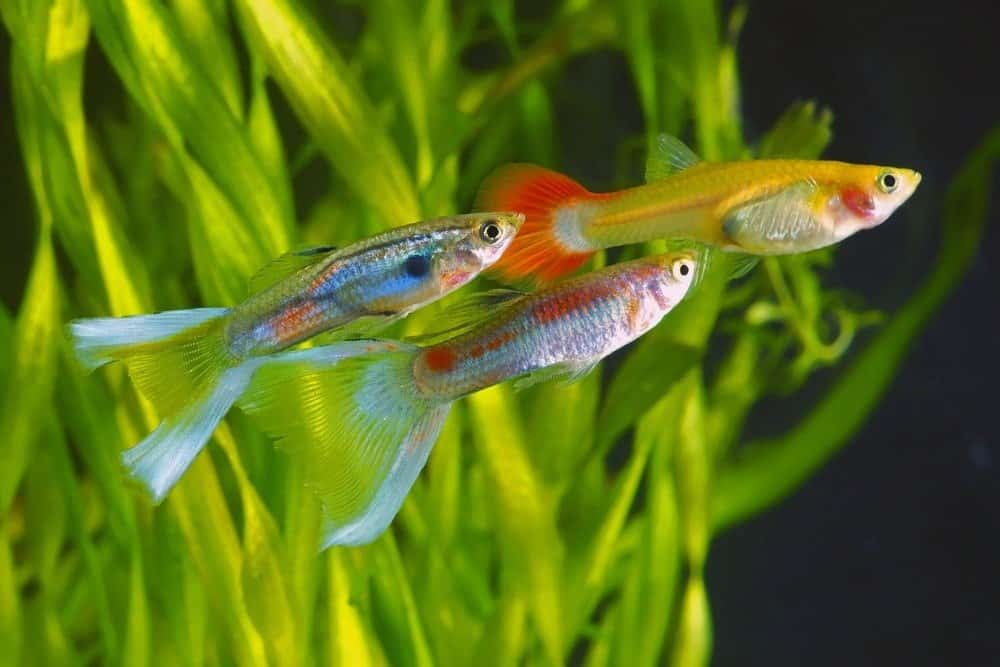
Guppies are pregnant for 21-31 days.
©Grigorev Mikhail/Shutterstock.com
Types of Guppies
Guppies are small tropical fish in the family Poeciliidae. Other names for this fish include “rainbow fish” and “millionfish.” There are approximately 300 species of guppies in the world. Though they are common as pets, they are also found in tropical settings in the wild. Some of the most common include:
- Common or fancy guppy (Poecilia reticulata)
- Scarlet livebearer (Micropoecilia picta)
- Endler’s guppy (Poecilia wingei)
Guppy Appearance and Size
Guppies come in a variety of shapes, sizes, and colours. Guppy colours are incredibly diverse and include white, black, blue, neon blue, green, orange, red, yellow, purple, bronze, platinum, and gold. Many different patterns and colour mixtures are possible including koi, panda, tuxedo, bicolour, and multicolour.
Guppy tails take many different shapes. Common tail types are bottom sword tail, crown tail, delta tail, lace tail, needle tail, round tail, double sword tail, and fan tail. Male guppies are more colourful and stylized than females.
Female guppies are typically larger than males, ranging in size from 1.2-2.4 inches long. Males range from 0.6-1.4 inches in length.
Guppy Diet and Predators
Guppies are omnivores, eating both plant and animal matter. In the wild, they eat algae, plant particles, insect larvae, and brine shrimp. Pet guppies can also be fed fish flakes, vegetable pellets, and bits of meat. The key to a healthy guppy is a wide variety of nutritious foods.
Being small in size, guppies are prey for a number of animals. Pike cichlids, blue acara, kingfishers, and various other birds and fish all eat guppies. Brightly coloured males are the most vulnerable, leading females to mate with the less flamboyant specimens. In the wild, guppies congregate in large groups to increase their chances of survival.
Guppy Habitat
Guppies live in both fresh and brackish water in many tropical regions of the world. They are native to South America but have spread virtually everywhere but Antarctica. Brazil, Barbados, Antigua, Guyana, Jamaica, Venezuela, the U.S. Virgin Islands, and Trinidad and Tobago all have robust guppy populations.
Coastal streams are the preferred guppy habitat, but they also inhabit pools, marshes, and lakes. They thrive in warm water between 72 and 79 degrees Fahrenheit. Neutral or alkaline water of pH 7 or greater ensures an optimal environment.
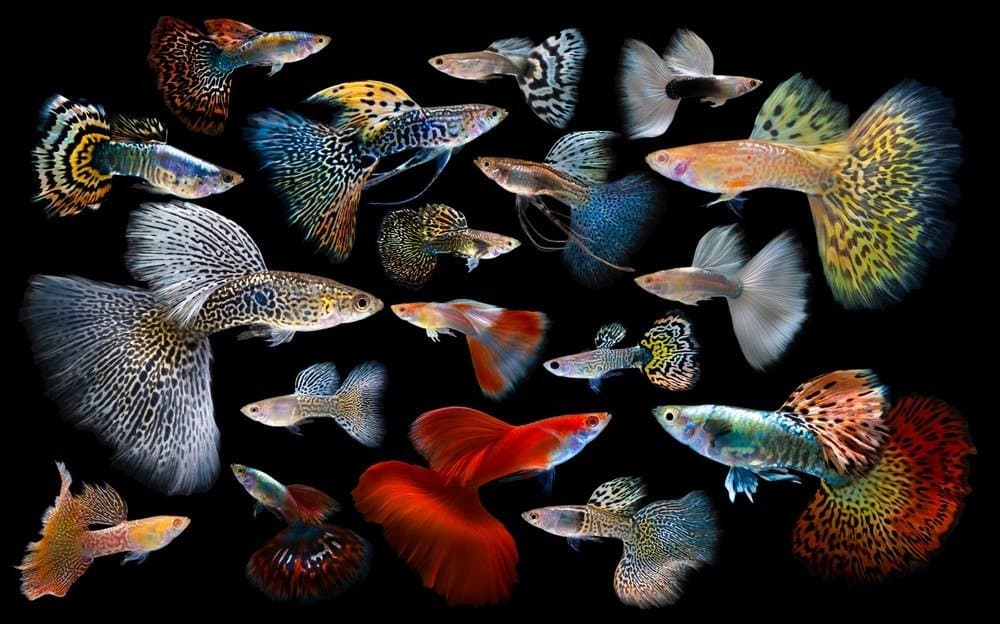
Guppies are social animals and breed voraciously given the chance.
©panpilai paipa/Shutterstock.com
Guppy Social Behaviour
Guppies are friendly, active fish that do well in a group environment. They easily shoal (group together with) a number of other fish species. Lone guppies do not do as well as guppies with companions, whether from their own species or not.
Guppies often mimic other guppies’ social behaviour, including their choice of mate. Scientists experimenting with guppy reproduction noticed that female guppies tended to choose mates that had already been selected by other female guppies. This desire to mimic seems to be genetic and is present in a vast number of species throughout the animal kingdom.
Guppy Reproduction and Lifespan
Guppies are ovoviviparous, which means that their eggs are fertilized inside the mother and hatch before she gives birth to live young. Insemination happens in less than a second. Males wanting to mate will chase their chosen female around until they catch her. She will make this process difficult by continually swimming away and even hiding from him. When the male gets close enough, he will rapidly insert his gonopodium (anal fin) into her anal vent. A tube inside the gonopodium facilitates the transfer of sperm from the male to the female.
The male repeats this process several times to make sure the mating was successful. The action is so quick that it’s easy for humans to miss it, even if they’re watching for it. Females may also engage in polyandry (mating with multiple candidates) to ensure a pregnancy.
Females can store sperm packets from past mating sessions to create future pregnancies without needing another insemination. They can do this for up to 10 months after the fact. For this reason, guppy breeding in aquariums can easily get out of hand as the number of guppies multiplies exponentially.
Guppies live an average of 2-3 years. However, in captivity, they can live up to 5 years with the proper care. This amounts to many, many potential pregnancies.
How Long Are Guppies Pregnant?
Guppies are pregnant for 21-31 days on average, though the birth usually falls in between 22-28 days. The delivery may take longer if the water is cold or if other fish in the tank are causing her stress.
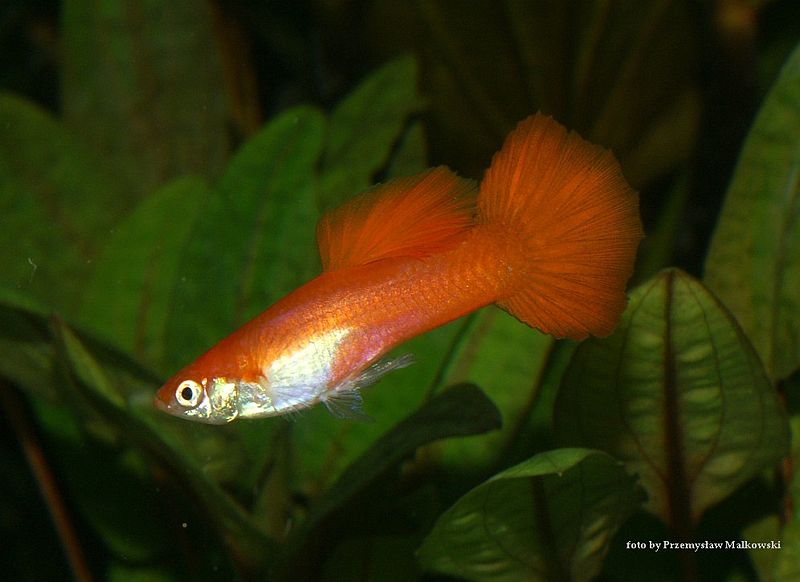
Guppies can get pregnant about once a month under optimal conditions.
©Przemysław Malkowski / CC BY-SA 3.0 – License
How Can You Tell If a Guppy is Pregnant?
Pregnant female guppies will typically increase in size and weight, especially around the abdomen. The belly may be distended more to one side or the other, sometimes even taking on a boxy shape. Her gravid spot, a dark spot near her anal vent, may also become more prominent as the pregnancy progresses. As the time for the birth approaches, the spot will darken until it is almost black.
Pregnant females often become more aggressive, especially toward males, who may still attempt to mate with them. They grow increasingly territorial and elusive, searching for a secluded place to give birth to their fry. They also eat less and may spit out whatever they do eat.
How Often Can Guppies Get Pregnant?
Guppies can get pregnant about once a month under optimal conditions. Warm water and plenty of food will encourage mating. Females with extra sperm packets will likely continue to produce fry without needing to mate with another male. As female guppies reach sexual maturity by 10-20 weeks of age, they are capable of giving birth many times throughout their lives. Male guppies are sexually mature by 7 weeks.
How Many Fry Can Guppies Produce at Once?
Guppies can produce between 20 and 50 fry at one time, though in extreme cases, they may produce well over 100. Fry are born fully formed and look like miniature adults.
Unfortunately, guppies often engage in filial cannibalism, which is the eating of one’s own young. Female guppies lack any sort of maternal instinct after the fry are born, freely eating both their young and the young of other guppies. If pet owners wish to raise the fry to adulthood, it’s best to remove them to a separate environment until they are old enough to defend themselves.
If you plan to keep guppies as pets, it’s important to understand their reproductive systems and how quickly they can breed. Otherwise, you might find your fish tank quickly becoming too small for an exploding population.
What Are the Worms Coming Out of My Guppy?
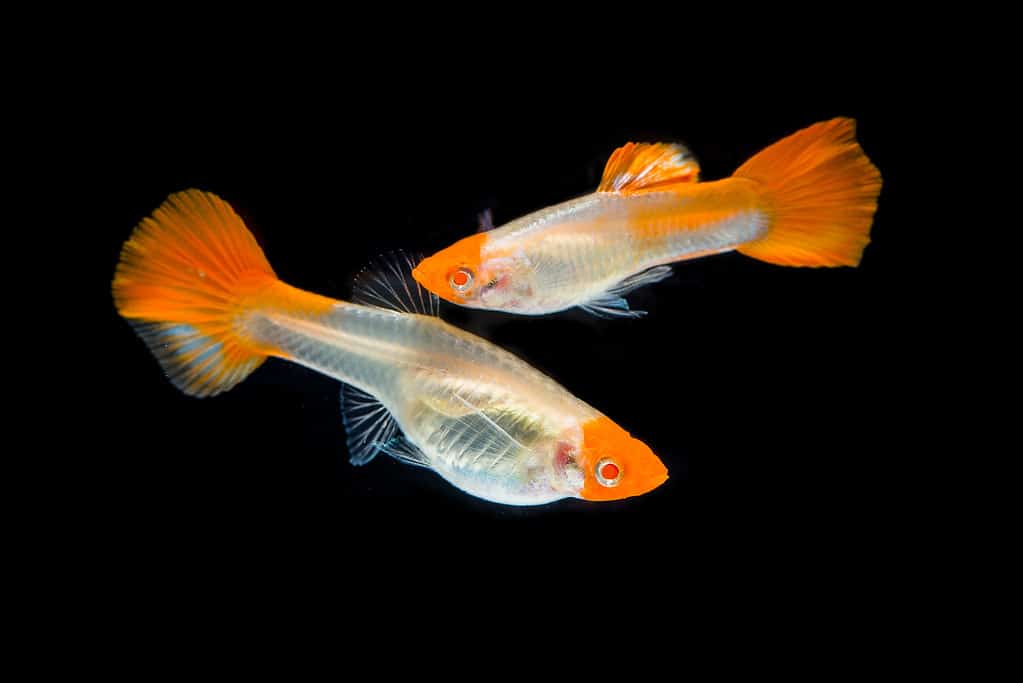
For guppies and other livebearers, you need to keep an eye out for worms that will be noticeable.
©GOLFWORA/Shutterstock.com
While we are talking about what to look for when your guppies may or may not be pregnant, you want to also be looking for something very serious and potentially lethal to your little fish.
Something that might occur in livebearing fish, like guppies, is the presence of camallanus red worms. These can be very troubling for your fish tank and its population of fish and other animals. In particular, they can kill your guppies because of their tiny size. Other larger fish may be able to survive being subjected to worms because their larger bodies are able to sustain them and unfortunately pass them on through their feces. As they do this, more and more of the aquarium is exposed to the worms. Another way of spreading camallanus red worms is by introducing rocks from other contaminated fish tanks into your fish tank.
The photo featured at the top of this post is © Nantawat Chotsuwan/Shutterstock.com
Thank you for reading! Have some feedback for us? Contact the AZ Animals editorial team.





